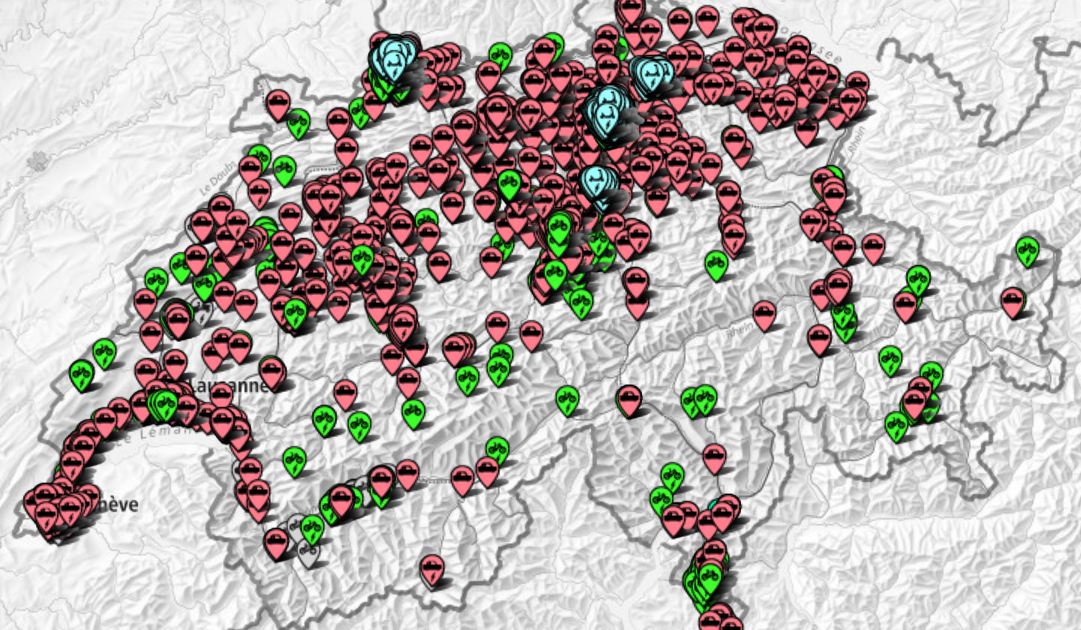Sharing is the new owning: This is especially true for mobility. The red Mobility vehicles are present in road traffic. Bicycles and scooters are available for hire in many cities. The new sharedmobility.ch platform bundles the various offers for the first time - freely accessible to all. The platform shows where a ride is available in real time.
Energeiaplus asked two providers why they are represented on sharedmobility and what they expect from the new platform.
Publibike is one of about ten bike-sharing providers. 5000 vehicles (e-bikes and normal bikes) are available at 500 locations in 8 Swiss cities. Anyone wishing to borrow a bike must first register. The bike can then be "rented" via an app or with the Swisspass.
Energeiaplus: The Publibike app shows whether there is a free bike at the desired station. Thomas Hug, you are Head of Business Development, why is Publibike also represented on sharedmobility.ch?
In order to change mobility in a sustainable way, it is important that the population is aware of the diverse offers available to them. Since these offers often vary from region to region, it makes sense to bundle them on one platform for the sake of simplicity.
What do you expect from this?
With around 150,000 users, we have already gained a broad base of regular customers. We also work together with various companies that support their employees in increasingly cycling to work. The sharedmobility.ch platform gives us the opportunity to address people who are not yet familiar with these sharing offers. In addition, in order to strengthen this form of mobility, cross-provider platforms are needed.
The federal government supports the sharedmobility.ch platform through the SwissEnergy programme. Why do you think this makes sense?
Shared Mobility has the potential to change our habits dramatically. It seems to me to make sense for the Confederation to get to grips with these offerings at an early stage and to move into the future together with providers.
Do you see potential for further development of sharedmobility.ch?
On the Publibike app, for example, you can also call up the battery status of the e-bikes. The sharedmobilitiy.ch platform does not currently show this. It could also be interesting to display historical data. In this way, one could see where and when the vehicles are normally available. It could also be useful if the map could be filtered by vehicle and provider.
On sharedmobility.ch you can also find the locations of the e-scooter providers. One of them is Voiscooters. The Swedish provider rents out its scooters in various countries, in Switzerland currently in the three cities of Basel, Zurich and Winterthur with a total of 1500 scooters. Bern is to be added soon.
Energeiaplus: Jasmin Rimmele, the Voi locations can also be found on the new sharedmobility.ch platform. Why?
Mobility platforms are an important part of driving the transport revolution forward. We see ourselves as part of urban mobility and as a complement to public transport. In Switzerland, we work closely with the SBB. We are integrated into the Smart and Yumuv applications there. Customers can book and pay directly via this app.
63 percent of our Swiss users say they use the Voi Trottinette in combination with public transport. We hope that we can expand these usage figures even further.
What do you expect from the new sharedmobility.ch platform?
The locations and availability of vehicles will be publicly visible. Through such Open Data solutions, they can be integrated into other mobility platforms. This is an important step towards making our offering more transparent for users, but also for city and research partners.
E-scooters are still very new compared to other means of transport.
Stakeholders thus have the opportunity to use and explore the offer without having to use them directly.
At the same time, we hope to attract new customers thanks to the platform. Currently, two thirds of our customers are between 19 and 39 years old. We still see potential for growth there.
How sensible is it for the federal government to be committed to Shared Mobility?
We have very few data bases at European level. In many cases, therefore, there is overregulation because decision-makers lack the criteria for the characteristics and advantages of e-scooters or shared micromobility. Data makes it clear where demand exists and informs which infrastructure projects need to be pushed forward in order to guarantee safety on the roads.
How should the platform be further developed in your eyes?
Our ideal scenario would be a digital transport planning platform from the public sector, through which every route from A to B can be planned and processed multimodally. We are convinced that there will be no alternative to such a platform in the long term.
And just: A deeper engagement with data at the municipal level in terms of infrastructure and education.
The interviews were conducted by Brigitte Mader, Communications, Swiss Federal Office of Energy


 BFERauchende Köpfe für CO2 Neutralität: Open Energy Data Hackdays 2020 in Brugg
BFERauchende Köpfe für CO2 Neutralität: Open Energy Data Hackdays 2020 in Brugg  Regionale Kooperation ist (k)ein Kinderspiel
Regionale Kooperation ist (k)ein Kinderspiel  Hohe Bedeutung der zivilen nuklearen Wissenschaften und Technologien
Hohe Bedeutung der zivilen nuklearen Wissenschaften und Technologien  ShutterstockDiminuer sa consommation d’électricité grâce aux capteurs
ShutterstockDiminuer sa consommation d’électricité grâce aux capteurs 
 Gemeinde Vilters-Wangs
Gemeinde Vilters-Wangs
Trackbacks & Pingbacks
[…] Energieplus Link auf die Thematik des BFE und von Energieplus […]
Dein Kommentar
An Diskussion beteiligen?Hinterlassen Sie uns Ihren Kommentar!